When you discover unwanted rodent visitors in your home, identifying whether you’re dealing with mice vs rats is crucial for effective pest control. While these rodents might seem similar at first glance, they have distinct characteristics that affect how they behave, where they nest, and most importantly – how to effectively remove them from your property.
- Mice vs Rats – How are They Different From Each Other?
- How Can I Tell Which One Invaded My Home?
- Behavioral Differences: Understanding Your Rodent Problem
- Health Risks: Why Identification Matters
- Reproduction Rates: Why Immediate Action is Crucial
- Effective Control Methods Based on Identification
- Frequently Asked Questions
Mice vs Rats – How are They Different From Each Other?

Mice and rats are both members of the rodent family, but they differ significantly in appearance, behavior, and habitat preferences. Understanding these differences is essential for identifying which pest has invaded your home and implementing the most effective control methods.
| Feature | Mice | Rats |
|---|---|---|
| Size | Small, 3-4 inches body length | Larger, 7-10 inches body length |
| Weight | 0.5-1 ounce | Up to 16 ounces |
| Head | Triangular with pointed snout | Blunt, wedge-shaped |
| Ears | Large relative to head size | Smaller relative to head size |
| Eyes | Larger, more prominent | Smaller, beady |
| Tail | Thin, long, covered with fine hair | Thick, scaly, relatively hairless |
| Fur | Softer, lighter colors | Coarser, darker colors |
Size and Appearance Differences
The most obvious difference between mice and rats is their size. Mice are significantly smaller than rats, with a house mouse typically measuring just 3-4 inches in body length, while rats can reach 7-10 inches (not including the tail).
Mouse Characteristics
- Triangular head with pointed snout
- Large ears relative to head size
- Small, slender body (3-4 inches)
- Thin, hairy tail about equal to body length
- Softer, lighter colored fur (gray, brown, white)
Rat Characteristics
- Blunt, wedge-shaped head
- Smaller ears relative to head size
- Larger, robust body (7-10 inches)
- Thick, scaly tail usually shorter than body
- Coarser, darker fur (brown, black, gray)
If you only get a quick glimpse of the rodent, look at the ears. Mouse ears appear much larger in proportion to their heads compared to rat ears, which appear smaller and more fitted to their head.
Dietary Differences: They Aren’t Picky Eaters
Both mice and rats are omnivores, meaning they’ll eat almost anything when hungry, but they do have distinct preferences that can help you identify which rodent you’re dealing with.
House Mice

- Prefer grains and seeds
- Will nibble frequently, eating 15-20 times per day
- Get water primarily from their food
- Hoard food close to nesting sites
- Often leave behind partially eaten food
Norway Rats
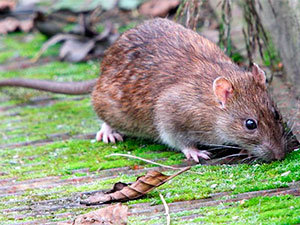
- Prefer protein-rich foods and meat
- Consume larger amounts in fewer feedings
- Need additional water sources
- More likely to eat entire food items
- Will travel further from nest to find food
Roof Rats
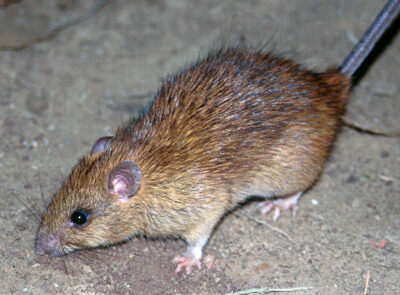
- Prefer fruits, nuts, and vegetables
- Eat foods with high moisture content
- More selective feeders than Norway rats
- Less likely to eat in the same location repeatedly
- Often feed in elevated locations
Rats and mice are not friendly neighbors. Rats are known to practice “muricide” – hunting, killing, and eating mice when they encounter them. Norway rats and roof rats will also fight each other fiercely if both species try to inhabit the same area.
How Can I Tell Which One Invaded My Home?
Since rodents are primarily nocturnal and often stay hidden, you may not actually see the culprits. However, there are several telltale signs that can help you determine whether you have a mouse or rat problem.
Physical Evidence: Droppings, Gnaw Marks, and Tracks
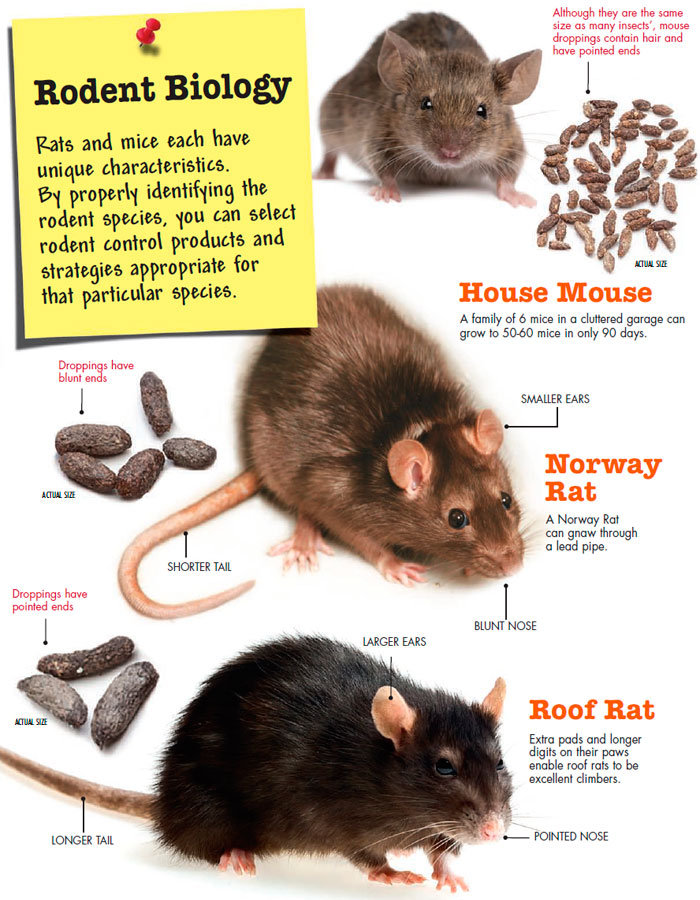
One of the most reliable ways to identify your rodent invader is by examining their droppings, which differ significantly between species.
| Rodent | Dropping Appearance | Size | Daily Amount |
|---|---|---|---|
| House Mouse | Small, pointed ends, rod-shaped | 1/8 – 1/4 inch (3-6mm) | 50-75 pellets |
| Norway Rat | Larger, blunt ends, capsule-shaped | 3/4 inch (19mm) | 40-50 pellets |
| Roof Rat | Medium-sized, pointed ends, curved | 1/2 inch (13mm) | 40-50 pellets |
Rodent droppings can contain harmful pathogens. Never handle them without proper protection. According to the CDC, rodents can spread over 35 diseases to humans through their urine, droppings, saliva, or through bites.
Gnaw Marks: Rats Have to Gnaw to Live

Rodents have continuously growing incisor teeth that require constant gnawing to keep them at a manageable length. However, the size and pattern of gnaw marks differ between mice and rats.
Tracking: You Can See Where They’ve Been

In environments with dust or loose soil, rodents leave distinctive tracks and tail drag marks that can help identify them.
Mouse Tracks
- Smaller footprints: hind foot ≈ 3/8 inch
- Often no visible tail drag marks
- Front feet have 4 toes, back feet have 5
- Tracks often appear in random patterns
Rat Tracks
- Larger footprints: hind foot ≈ 3/4 to 1 inch
- Visible tail drag marks between footprints
- Front feet have 4 toes, back feet have 5
- Tracks often follow established pathways
To identify tracks in your home, sprinkle a light dusting of flour or talcum powder in areas where you suspect rodent activity. Check the area the next morning to see if tracks are present and examine their characteristics.
Behavioral Differences: Understanding Your Rodent Problem
Mice and rats exhibit distinctly different behavioral patterns, which impacts how you should approach controlling them.
| Behavior | Mice | Rats |
|---|---|---|
| Curiosity Level | Very curious, will investigate new objects | Cautious, avoid new objects initially |
| Nesting Habits | Nest close to food sources | May travel 100-300 feet from nest to food |
| Territory Size | Small, 10-30 feet from nest | Larger, up to 300 feet from nest |
| Response to Traps | Readily investigate and enter traps | Show “neophobia” – fear of new objects |
| Social Structure | Can live in large family groups | More hierarchical, dominant males |
These behavioral differences have significant implications for control methods. For example, mice will often investigate and enter traps the first night they’re set, while rats may avoid traps for days until they become familiar with them.
Health Risks: Why Identification Matters
Both mice and rats pose significant health risks to humans, but they may carry different diseases, making proper identification important for health safety.
According to the CDC, rodents can spread over 35 diseases through direct contact with their droppings, urine, saliva, or through bites and scratches. Some diseases can also be spread indirectly through ticks, mites and fleas that have fed on infected rodents.
| Disease | Primary Carrier | Transmission Method |
|---|---|---|
| Hantavirus Pulmonary Syndrome | Deer mice, White-footed mice | Inhalation of virus particles from droppings, urine, saliva |
| Leptospirosis | Rats (particularly Norway rats) | Contact with water/soil contaminated with urine |
| Lymphocytic Choriomeningitis (LCM) | House mice | Inhalation or direct contact with virus particles |
| Rat-Bite Fever | Rats (can also be transmitted by mice) | Bites, scratches, or contact with a dead rodent |
| Salmonellosis | Both mice and rats | Food or water contaminated with feces |
Beyond health concerns, rodents cause significant property damage. According to the National Pest Management Association, rodents are responsible for up to 25% of undetermined house fires in the U.S. by gnawing on electrical wires.
Reproduction Rates: Why Immediate Action is Crucial

One of the most alarming aspects of rodent infestations is how quickly they can multiply. Understanding the rapid reproduction rates helps emphasize why immediate action is necessary.
Mice reach sexual maturity when they are about six weeks old and live an average of nine to twelve months. Female mice can have as many as ten litters during their lifetime, each with five to six pups. That adds up to 60 new mice a year for each female.
Rats reach sexual maturity when they’re about three months old and live for a year to eighteen months. Female rats average six litters a year, with as many as 12 babies each litter.
All these young rodents begin reproducing quickly, creating a potential population explosion in your home.
Effective Control Methods Based on Identification
Different control methods work better for mice versus rats due to their behavioral differences. Using the right approach based on proper identification will yield better results.
| Control Method | Effectiveness for Mice | Effectiveness for Rats |
|---|---|---|
| Snap Traps | Highly effective; place many small traps | Effective but require pre-baiting period |
| Glue Traps | Effective for mice | Less effective; rats may avoid or escape |
| Ultrasonic Repellers | Limited effectiveness, habituation occurs | Limited effectiveness, habituation occurs |
| Baits/Rodenticides | Effective with proper placement | Effective but rats may be wary of new foods |
| Exclusion Methods | Seal holes larger than 1/4 inch | Seal holes larger than 1/2 inch |
The most effective rodent control starts with sanitation. Removing food sources and clutter can dramatically reduce rodent populations before trapping or baiting begins.
Frequently Asked Questions
Do mice grow up to be rats?
No, mice do not grow up to be rats. They are completely different species with distinct genetic makeups, despite their similar appearance. A baby rat (called a pup or kitten) will have the physical characteristics of an adult rat (like a more blunt face) even at a young age, while a mouse has its own distinct features regardless of age.
How big do mice get compared to rats?
Mice are significantly smaller than rats. An adult house mouse typically weighs only 0.5-1 ounce and has a body length of 3-4 inches, with a tail of similar length. In contrast, adult rats can weigh 8-16 ounces (up to a pound) and have body lengths of 7-10 inches, with tails that may be shorter than their bodies.
Can mice and rats live together peacefully?
No, mice and rats do not coexist peacefully. Rats are natural predators of mice and will hunt, kill, and eat them when they encounter them—a behavior known as “muricide.” If you have both mice and rats in your home, the rats will likely prey on the mice unless food is extremely abundant and their paths rarely cross.
Will a rat eat a mouse?
Yes, rats will eat mice. This predatory behavior is called “muricide.” Rats have a significant size and strength advantage over mice, leaving mice with virtually no chance of survival in a direct encounter. Both rodents have similar movement speeds, but rats have superior jumping ability and can detect mice through their keen senses of smell, hearing, and touch.
Which is worse to have in your home, mice or rats?
Both pests pose serious health and property damage risks, but rats generally cause more extensive damage due to their larger size and stronger teeth. Rats can chew through harder materials including some concrete, soft metals, and electrical wiring. However, mice can fit through smaller spaces (as small as 1/4 inch) and tend to reproduce more rapidly, potentially leading to larger infestations.
How do I know if I have rats or mice in my home?
You can determine whether you have rats or mice by examining droppings (rat droppings are larger, about 3/4 inch, while mouse droppings are 1/4 inch or less), gnaw marks (rat marks are larger and deeper), tracks (rats leave tail drag marks), and nesting locations (rats often burrow, while mice nest in hidden areas near food). If you see the actual rodent, note the size, ear proportions, and tail characteristics.
Understanding the differences between rats and mice is crucial for effective pest control. By identifying key physical characteristics and behavioral patterns, you can implement the appropriate methods to eliminate these unwanted guests from your home. Remember that both rodents reproduce rapidly, so prompt action is essential once you detect their presence.
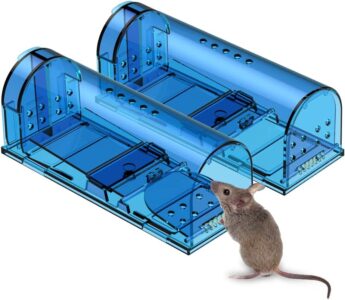
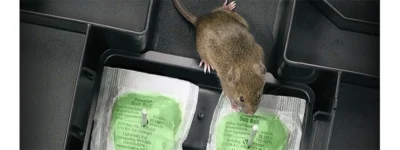


Another bad winter for mice /rats the ones I’ve been getting so far are small , but I’ve been noticing the face, nose the length is a little long , are they small rats or mice ?????
Thank you for your practical Knowledge. Do you know how effective for rat control is a 50 50 mixture of corn meal and sugar?